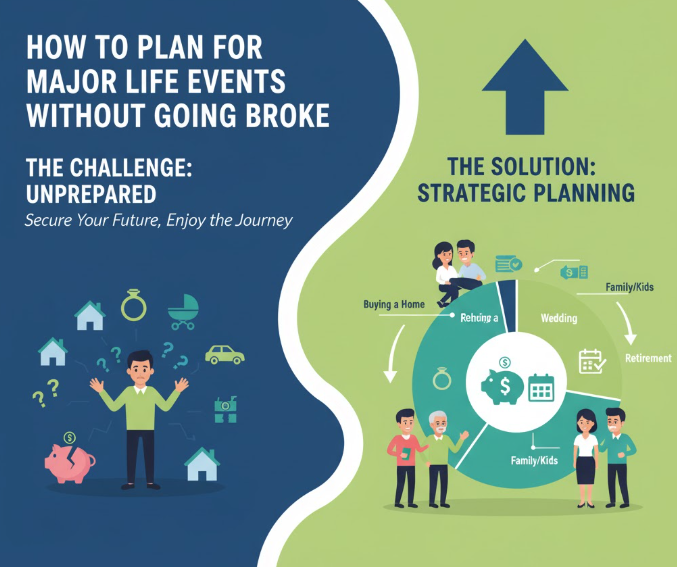Introduction: Big Moments, Bigger Expenses — How to Stay Financially Smart
Life is full of exciting milestones — getting married, buying a home, having a baby, or pursuing higher education. These moments are joyful and often life-changing, but they also come with hefty price tags. Many people fall into the trap of overspending or taking on unnecessary debt just to make these occasions “perfect.”
But here’s the truth: you can celebrate life’s biggest events without breaking the bank.
The secret lies in planning ahead, budgeting smartly, and prioritizing what truly matters.
This detailed guide will show you how to prepare financially for major life events like weddings, home purchases, relocations, or retirement — while keeping your wallet (and peace of mind) intact.
H2: Why Financial Planning for Life Events Matters
When you plan your finances properly, you do more than just save money — you buy yourself freedom, control, and confidence.
Without planning, even joyful moments can become stressful. Financial stress not only affects your bank account but can also harm your relationships and health.
Here’s why smart planning matters:
-
You can avoid debt traps and last-minute borrowing.
-
You’ll have clear priorities and won’t overspend on unnecessary luxuries.
-
You can enjoy your special day or milestone without constant worry about bills.
-
You’ll build long-term security, even after the event ends.
H2: Step-by-Step Guide to Planning for Major Life Events Without Going Broke
Each major milestone in life needs its own strategy — but the core idea is the same: plan early, save smartly, and spend wisely.
Let’s break this down step by step.
H3: Step 1 – Identify the Major Life Events Ahead
The first step is to list the key milestones you expect in the next 5–10 years. Everyone’s list will look different, but here are some common ones:
| Category | Life Event | Approximate Cost (USD) |
|---|---|---|
| Personal | Wedding | $10,000 – $40,000 |
| Family | Having a Baby | $5,000 – $15,000 (first year) |
| Education | College/University | $20,000 – $100,000+ |
| Housing | Buying a Home | 10–20% of home value (down payment) |
| Career | Business Startup | $5,000 – $50,000 |
| Retirement | Post-Retirement Living | $1,000/month (minimum) |
Knowing what’s coming next helps you set the right priorities and start saving early.
H3: Step 2 – Estimate the Costs Realistically
Once you know what you’re planning for, the next step is cost estimation.
Most people underestimate how much they’ll actually spend — this leads to financial shock later.
Tips to estimate costs correctly:
-
Research current prices (venues, travel, furniture, education fees, etc.)
-
Add 10–20% extra as a safety buffer for unexpected expenses
-
Break down large costs into smaller categories — for example:
-
Wedding: venue, clothes, catering, photography, honeymoon
-
New Home: down payment, renovation, moving costs, utilities
-
Baby: hospital, clothes, furniture, diapers, health care
-
This gives you a realistic picture of what you’ll need to save.
H3: Step 3 – Create a Dedicated Savings Plan
One of the smartest financial habits is to create separate savings accounts for major goals.
This keeps your money organized and prevents you from dipping into your long-term funds.
How to do it:
-
Open goal-based savings accounts — e.g., “Wedding Fund,” “Baby Fund,” or “Dream Home Fund.”
-
Automate monthly transfers into each account.
-
Start with small amounts and gradually increase them as your income grows.
-
Use high-yield savings or investment accounts to earn interest.
💡 Pro Tip: Even saving $100/month consistently for 5 years equals $6,000+, not counting interest!
H3: Step 4 – Set a Realistic Timeline
Every goal needs a deadline. Without it, saving will feel endless and directionless.
Let’s say you want to buy a house in 4 years. Break it down:
-
Total down payment needed: $20,000
-
Time available: 48 months
-
Monthly savings goal: $416
That’s how you turn big dreams into achievable plans.
Visual Example: Savings Timeline Chart
| Goal | Total Cost | Years to Save | Monthly Target |
|---|---|---|---|
| Wedding | $15,000 | 3 years | $417 |
| Baby Fund | $8,000 | 2 years | $334 |
| Home Down Payment | $20,000 | 4 years | $416 |
| Retirement Nest Egg | $250,000 | 30 years | $695 |
This table helps you visualize your roadmap and track progress easily.
H3: Step 5 – Budget Smartly and Cut Unnecessary Spending
Budgeting doesn’t mean sacrificing your happiness.
It means spending with purpose — aligning your daily expenses with your long-term dreams.
Simple 50/30/20 Rule
Use this rule to manage your income effectively:
-
50% – Needs (bills, groceries, rent)
-
30% – Wants (entertainment, outings)
-
20% – Savings & Investments
If you’re saving for a major event, consider adjusting to 40/20/40, giving more weight to savings temporarily.
Quick ways to free up cash:
-
Cook at home instead of eating out.
-
Cancel unused subscriptions.
-
Buy quality items that last longer.
-
Compare prices before big purchases.
-
Use cashback apps or coupons.
Each dollar you save today moves you closer to your milestone.
H3: Step 6 – Avoid Debt Traps and Overspending
When major events approach, many people feel pressured to spend beyond their means — often using credit cards or loans.
But debt can ruin the joy of any milestone if you’re stuck paying it off for years.
Ways to stay debt-free:
-
Avoid “buy now, pay later” offers unless absolutely necessary.
-
Use cash or debit cards to keep spending visible.
-
If you must borrow, choose low-interest options like personal loans with short terms.
-
Always calculate the true cost of debt (interest + hidden fees).
💬 Example:
If you borrow $10,000 at 15% interest for 3 years, you’ll end up paying over $12,400 total.
That’s $2,400 lost to interest — money that could’ve gone toward future goals.
H3: Step 7 – Invest Wisely to Grow Your Money
Saving is great — but investing helps your money work for you.
Depending on your comfort level and time horizon, consider:
-
Mutual Funds or ETFs – Balanced growth and diversification
-
Fixed Deposits or Bonds – Low-risk, stable returns
-
Retirement Accounts (e.g., IRA, Pension) – Long-term compounding
-
Stock Market or Index Funds – Higher returns (for longer-term goals)
⚠️ Tip: Never invest all your money in one place. Diversify to reduce risk.
Even modest investments can make a big difference.
Example:
Investing $200/month at 7% annual return for 10 years = $34,000+ saved!
H3: Step 8 – Protect Yourself with Emergency and Insurance Plans
Financial protection is crucial. Life is unpredictable — an illness, job loss, or accident can derail your savings.
Make sure you have:
-
Emergency Fund: 3–6 months of expenses in a separate account.
-
Health Insurance: Covers hospital and medical bills.
-
Life Insurance: Protects your family’s future if something happens to you.
-
Event-Specific Insurance: Especially useful for weddings, travel, or home purchases.
Having insurance ensures that one crisis doesn’t wipe out years of savings.
H3: Step 9 – Learn to Say “No” (to Peer Pressure and Perfection)
One of the biggest reasons people overspend is social pressure.
Whether it’s throwing an extravagant wedding or buying the latest gadgets — remember, your financial peace is worth more than social approval.
Practical advice:
-
Focus on what truly makes you happy.
-
Cut costs where it doesn’t affect the experience.
-
Be honest with loved ones about your budget limits.
-
Remember: memories matter more than material show-offs.
H3: Step 10 – Track, Review, and Adjust Regularly
Financial planning is not “set it and forget it.”
You need to review your progress every few months.
Use tools like:
-
Google Sheets or Excel for budgeting
-
Mobile apps (Mint, YNAB, PocketGuard)
-
Monthly expense trackers
Ask yourself:
-
Am I on track with my savings goal?
-
Can I increase my monthly contributions?
-
Have my priorities changed?
Small adjustments can help you stay on course and reach your milestones comfortably.
H2: How to Plan for Specific Life Events Without Going Broke
Now, let’s look at how to handle a few specific major milestones smartly.
H3: Planning for a Wedding on a Budget
Weddings are emotional — but they can also be financial black holes.
You don’t need to spend a fortune to make your day special.
Budget Wedding Tips:
-
Choose an off-season or weekday for discounts.
-
Limit your guest list — focus on close friends and family.
-
Rent dresses or décor instead of buying.
-
DIY invitations and decorations.
-
Skip unnecessary extras like fancy wedding favors.
💡 Average Saving Tip: A smaller, 100-guest wedding can save you $10,000–$15,000 compared to a grand 300-guest event.
H3: Buying a Home Without Emptying Your Savings
Your dream home shouldn’t turn into a financial nightmare.
Smart Home-Buying Tips:
-
Save at least 20% down payment to avoid high-interest loans.
-
Compare mortgage rates and hidden fees.
-
Don’t buy at the top of your budget — leave space for repairs and furniture.
-
Consider future costs (taxes, insurance, utilities).
-
Avoid emotional buying; focus on value, not vanity.
🏠 Golden Rule: Your monthly mortgage should be no more than 25–30% of your monthly income.

H3: Preparing Financially for Parenthood
Having a child is a blessing — but it’s also a big financial commitment.
Baby Budget Checklist:
-
Before birth: hospital fees, maternity clothes, baby furniture.
-
After birth: diapers, food, healthcare, childcare.
Cost-Saving Tips:
-
Buy second-hand baby gear in good condition.
-
Breastfeed if possible (it saves thousands yearly).
-
Take advantage of family gifts or hand-me-downs.
-
Start a child education savings plan early.
👶 Fact: The average cost of raising a child until age 18 can exceed $200,000+ — so early planning is essential.
H3: Saving for Education or Career Goals
Education can open doors — but it can also drain savings if you’re unprepared.
Tips for Affordable Education:
-
Apply for scholarships and grants.
-
Consider part-time work or online programs.
-
Choose community colleges or public universities for initial years.
-
Use 529 or education savings accounts.
🎓 Pro Tip: Always compare the Return on Investment (ROI) — choose programs that lead to high-paying or in-demand careers.
H3: Preparing for Retirement Early
Retirement may feel far away, but it’s one of the most expensive life stages.
Smart Retirement Moves:
-
Start saving in your 20s or 30s — compound interest is your friend.
-
Contribute to employer pension plans.
-
Invest in low-risk, long-term funds.
-
Minimize lifestyle inflation — live below your means.
📊 Example Chart: Power of Early Saving
| Starting Age | Monthly Savings | Total at 60 (7% Return) |
|---|---|---|
| 25 | $200 | $510,000 |
| 35 | $200 | $245,000 |
| 45 | $200 | $110,000 |
Starting early literally doubles or triples your retirement wealth.
H2: Bonus Tips to Stay Financially Strong During Life Changes
-
Build multiple income streams — freelancing, side hustles, passive income.
-
Stay financially educated — read books, attend workshops, follow finance blogs.
-
Avoid emotional spending — pause before big purchases.
-
Involve your partner or family — make financial planning a team effort.
-
Celebrate progress — small milestones deserve recognition too!
Conclusion: Celebrate Life — The Smart Way
Major life events are meant to be celebrated, not stressed over.
The key to enjoying them fully lies in planning early, saving consistently, and spending wisely.
Whether it’s your wedding, dream home, or retirement, remember — you don’t have to go broke to live beautifully.
Financial discipline doesn’t limit your happiness; it protects it.
Start small today — a single budget, a single goal — and watch how your financial confidence grows with every milestone.
✨ Your life’s big moments deserve joy — not debt. Plan smart, live free, and thrive.

